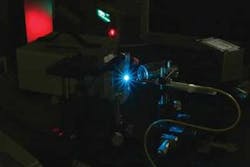Lord Rayleigh wrote about the two-dimensional whispering gallery mode (WGM) in 1910 after a visit to the dome of St. Paul’s cathedral in London. The whispering cave mode (WCM) is a three-dimensional (3-D) effect—a toroid with circular helix symmetry—which recent studies have shown can be used to create photonic-quantum-ring (PQR) lasers that emit in the blue-violet part of the spectrum.1
A research team at Pohang University of Science and Technology (POSTECH, Pohang, Korea) first created 3-D WCM lasers that emit in the infrared and red part of the spectrum. To achieve this, professor O’Dae Kwon and his group stacked mesas of vertically reflecting distributed-Bragg-reflector (DBR) structures above and below a few active 80 Å gallium arsenide and gallium indium phosphide quantum wells. The resulting 3-D WCM laser of photonic quantum rings avoided the problem of in-plane light spreading found in 2-D WGM lasers, and generated a doughnut-like band of 3-D helical modes. One such photonic-quantum-ring device 15 µm in diameter featured an ultralow threshold current of 11.5 µA, about a thousandth of that needed for vertical-cavity surface-emitting lasers (VCSELs) of the same diameter. These multimode devices emitted around a central wavelength of 848 nm, exhibiting increasing threshold current and decreasing linewidth with larger device diameter. The team observed the narrowest linewidth with an optical spectrum analyzer to date from a 10 µm PQR of 0.55 Å at an injection current of 800 µA.
The next iterations of the infrared PQR device involved single-mode electrically pumped lasers made of a hyperboloid drum shape only 0.9 µm across. These devices exhibited a linewidth of 0.46 Å at 838.5 µm, and a tiny threshold current of 300 nA, the smallest ever observed among quantum-well, wire, or dot-type lasers. Although the external quantum efficiency suffered from soft lasing turn-on behavior, the emission efficiency of the PQR laser was very high—more favorable than that of light-emitting diodes (LEDs). Such lasers could be used to replace LEDs in high-end displays in the near future.
The researchers then used various vertical gallium nitride (GaN) structures to extend their PQR work to blue wavelengths from 420 to 470 nm (see figure). In one version, a “reverse-mesa” approach with microholes etched in the vertical-quantum-well structure enabled unexpected “convex whispering-gallery” lasing via gain-guiding effects. This “weird” laser also exhibited very low quantum-ring-like thresholds (6 µA per pixel for 256 × 256 arrays, and 0.3 µA per pixel for megapixel arrays at room temperature) and surface-normal dominant multimode emissions. The hole lasers are easily fabricated, readily scalable, and, says Kwon, may become sought-after for next-generation interconnects or nanobioengineering for their potential to anchor submicron fibers.
“In general,” said Kwon, “the blue laser has been like a ‘holy grail’—it has been very difficult to achieve surface-normal lasing. Existing blue photonic-crystal laser diodes still require relatively high current. The new blue PQR achieves surface-normal lasing easily, even with the modest design of less than 95% to 70% vertical-pair reflection, thanks to the unique 3-D helix WCM phenomena. And its ultralow threshold implies it can outperform LEDs while overcoming the thermal and material problems of the LED.”
Future challenges associated with 3-D WCM PQR lasers include studies of 3-D device theory and simulations, angular moment studies, understanding of carrier-photon interactions, and chaotic dynamics research on modified structures.
REFERENCE
1. O. Kwon et al., Proc. SPIE Photonics West, 6872, (2008).

